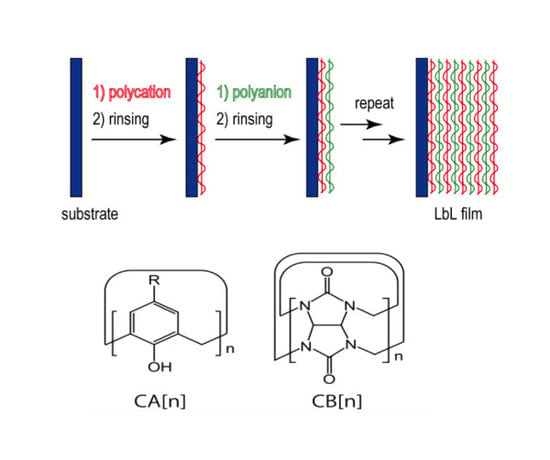Host-Guest Chemistry in Layer-by-Layer Assemblies Containing Calix[n]arenes and Cucurbit[n]urils: A Review
Abstract
:1. Introduction
2. CA[n]-Containing LbL Films
3. CB[n]-Containing LbL Films
3.1. LbL Films on Flat Substrates
3.2. LbL Films Coated on the Surface of Colloidal Particles and Nanopores
4. Conclusions
Acknowledgments
Author Contributions
Conflicts of Interest
References
- Decher, G.; Hong, J.D.; Schmitt, J. Buildup of ultrathin multilayer films by a self-assembly process: III. Consecutively alternating adsorption of anionic and cationic polyelectrolytes on charged surfaces. Thin Solid Films 1992, 210, 831–835. [Google Scholar] [CrossRef]
- Lvov, Y.; Decher, G.; Möhwald, H. Assembly, structural characterization, and thermal behavior of layer-by-layer deposited ultrathin films of poly(vinyl sulfate) and poly(allylamine). Langmuir 1993, 9, 481–486. [Google Scholar] [CrossRef]
- Tomita, S.; Sato, K.; Anzai, J. Layer-by-layer assembled thin films composed of carboxyl-terminated poly(amidoamine) dendrimer as a pH-sensitive nano-device. J. Colloid Interface Sci. 2008, 326, 35–40. [Google Scholar] [CrossRef] [PubMed]
- Kharlampieva, E.; Kozlovskaya, V.; Sukhishvili, S.A. Layer-by-layer hydrogen-bonded polymer films: From fundamentals to applications. Adv. Mater. 2009, 21, 3053–3065. [Google Scholar] [CrossRef]
- Akiba, U.; Anzai, J. Cyclodextrin-containing layer-by-layer films and microcapsules: Synthesis and applications. AIMS Mater. Sci. 2017, 4, 832–846. [Google Scholar] [CrossRef]
- Shimazaki, Y.; Mitsuishi, M.; Ito, S.; Yamamoto, M. Preparation of the layer-by-layer deposited ultrathin film based on the charge-transfer interaction. Langmuir 1997, 13, 1385–1387. [Google Scholar] [CrossRef]
- Chen, G.; Wang, X.; Liu, A.; Qian, D. Layer-by-layer assembly of poly(p-xylyleneviologen)-DNA multilayers and their electrochemical properties. Mater. Sci. Eng. C 2009, 29, 925–929. [Google Scholar] [CrossRef]
- Zayas-Gonzalez, Y.M.; Lynn, D.M. Degradable amine-reactive coatings fabricated by the covalent layer-by-layer assembly of poly(2-vinyl-4,4-dimethylazlactone) with degradable polyamine building blocks. Biomacromolecules 2016, 17, 3067–3075. [Google Scholar] [CrossRef] [PubMed]
- Anzai, J.; Kobayashi, Y.; Suzuki, Y.; Takeshita, H.; Chen, Q.; Osa, T.; Hoshi, T.; Du, X. Enzyme sensors prepared by layer-by-layer deposition of enzymes on a platinum electrode through avidin-biotin interaction. Sens. Actuators B 1998, 52, 3–9. [Google Scholar] [CrossRef]
- Yoshida, K.; Hasebe, Y.; Takahashi, S.; Sato, K.; Anzai, J. Layer-by-layer deposited nano- and micro-assemblies for insulin delivery: A review. Mater. Sci. Eng. C 2014, 34, 384–392. [Google Scholar] [CrossRef] [PubMed]
- Onda, M.; Ariga, K.; Kunitake, T. Activity and stability of glucose oxidase in molecular films assembled alternately with polyions. J. Biosci. Bioeng. 1999, 87, 69–75. [Google Scholar] [CrossRef]
- Wang, B.; Anzai, J. Redox reactions of ferricyanide ions in layer-by-layer deposited polysaccharide films: A significant effect of the type of polycation in the films. Langmuir 2007, 23, 7378–7384. [Google Scholar] [CrossRef] [PubMed]
- Crouzier, T.; Boudou, T.; Picart, C. Polysaccharide-based polyelectrolyte multilayers. Curr. Opin. Colloid Interface Sci. 2010, 15, 417–426. [Google Scholar] [CrossRef]
- Sato, H.; Anzai, J. Preparation of layer-by-layer thin films composed of DNA and ferrocene-bearing poly(amine)s and their redox properties. Biomacromolecules 2006, 7, 2072–2076. [Google Scholar] [CrossRef] [PubMed]
- Johnston, A.P.R.; Caruso, F. Stabilization of DNA multilayer films through oligonucleotide crosslinking. Small 2008, 4, 612–618. [Google Scholar] [CrossRef] [PubMed]
- Li, Y.; Huang, H.; Li, Y.; Su, X. Highly sensitive fluorescent sensor for mercury (II) ion based on layer-by-layer self-assembled films fabricated with water-soluble fluorescent conjugated polymer. Sens. Actuators B 2013, 188, 772–777. [Google Scholar] [CrossRef]
- Sato, K.; Takahashi, S.; Anzai, J. Layer-by-layer thin films and microcapsules for biosensors and controlled release. Anal. Sci. 2012, 28, 929–938. [Google Scholar] [CrossRef] [PubMed]
- Takahashi, S.; Anzai, J. Recent progress in ferrocene-modified thin films and nanoparticles for biosensors. Materials 2013, 6, 5742–5762. [Google Scholar] [CrossRef] [PubMed]
- Yoshida, K.; Sato, K.; Anzai, J. Layer-by-layer polyelectrolyte films containing insulin for pH-triggered release. J. Mater. Chem. 2010, 20, 1546–1552. [Google Scholar] [CrossRef]
- Pál, E.; Sebök, D.; Hornok, V.; Dékány, I. Structure, optical, and adsorption properties of ZnO2/poly(acrylic acid) hybrid thin porous films prepared by ionic strength controlled layer-by-layer method. J. Colloid Interface Sci. 2009, 332, 173–182. [Google Scholar] [CrossRef] [PubMed]
- Liang, X.; Kozlovskaya, V.; Chen, Y.; Zavgorodnya, O.; Kharlampieva, E. Thermosensitive multilayer hydrogels of poly(N-vinylcaprolactam) as nanothin films and shaped capsules. Chem. Mater. 2012, 24, 3707–3719. [Google Scholar] [CrossRef] [PubMed]
- Wang, X.; Chen, W.; Zhang, J.; Li, C.; Zhuo, R.; Zhang, X. Design of a photoswitchable hollow microcapsular drug delivery system by using a supramolecular drug-loading approach. J. Phys. Chem. B 2011, 115, 13796–13802. [Google Scholar]
- Sato, K.; Kodama, D.; Naka, Y.; Anzai, J. Electrochemically induced disintegration of layer-by-layer-assembled thin films composed of 2-iminobiotin-labeled poly(ethyleneimine) and avidin. Biomacromolecules 2006, 7, 3302–3305. [Google Scholar] [CrossRef] [PubMed]
- Watahiki, R.; Sato, K.; Suwa, K.; Niina, S.; Egawa, Y.; Seki, T.; Anzai, J. Multilayer films composed of phenylboronic acid-modified dendrimers sensitive to glucose under physiological conditions. J. Mater. Chem. B 2014, 2, 5809–5817. [Google Scholar] [CrossRef]
- Wang, B.; Anzai, J. Recent progress in lectin-based biosensors. Materials 2015, 8, 8590–8607. [Google Scholar] [CrossRef] [PubMed]
- Sato, K.; Suzuki, I.; Anzai, J. Preparation of polyelectrolyte-layered assemblies containing cyclodextrin and their binding properties. Langmuir 2003, 19, 7406–7412. [Google Scholar] [CrossRef]
- Sansone, F.; Baldini, L.; Casnati, A.; Ungaro, R. Calixarenes: From biomimetic receptors to multivalent ligands for biomolecular recognition. New J. Chem. 2010, 34, 2715–2728. [Google Scholar] [CrossRef]
- Gezici, O.; Bayrakci, M. Calixarene-engineered surfaces and separation science. J. Incl. Phenom. Macrocycl. Chem. 2015, 83, 1–18. [Google Scholar] [CrossRef]
- Ovsyannikov, A.; Solovieva, S.; Antipin, I.; Ferlay, S. Coordination polymers based on calixarene derivatives: Structures and properties. Coord. Chem. Rev. 2017, 352, 151–186. [Google Scholar] [CrossRef]
- Walker, S.; Oun, R.; McInnes, F.J.; Wheate, N.J. The potential of cucurbit[n]urils in drug delivery. Isr. J. Chem. 2011, 51, 616–624. [Google Scholar] [CrossRef]
- Masson, E.; Ling, X.; Joseph, R.; Kyeremeh-Mensah, L.; Lu, X. Cucurbituril chemistry: A tale of supramolecular success. RSC Adv. 2012, 2, 1213–1247. [Google Scholar] [CrossRef]
- Gürbüz, S.; Idris, M.; Tuncel, D. Cucurbituril-based supramolecular engineered nanostructured materials. Org. Biomol. Chem. 2015, 13, 330–347. [Google Scholar] [CrossRef] [PubMed]
- Das, D.; Scherman, O.A. Cucurbituril: At the interface of small molecule host-guest chemistry and dynamic aggregates. Isr. J. Chem. 2011, 51, 537–550. [Google Scholar] [CrossRef]
- Kaifer, A.E. Electrochemical properties of cucurbit[7]uril complexes of ferrocenyl derivatives. Inorg. Chim. Acta 2017, 468, 77–81. [Google Scholar] [CrossRef]
- Jeon, Y.J.; Bharadwaj, P.K.; Choi, S.W.; Lee, J.W.; Kim, K. Supramolecular amphiphiles: Spontaneous formation of vesicles triggered by formation of a charge-transfer complex in a host. Angew. Chem. Int. Ed. 2002, 41, 4474–4476. [Google Scholar] [CrossRef]
- Yang, X.; Johnson, S.; Shi, J.; Holesinger, T.; Swanson, B. Polyelectrolyte and molecular host ion self-assembly to multilayer thin films: An approach to thin film chemical sensors. Sens. Actuators B 1997, 45, 87–92. [Google Scholar] [CrossRef]
- Hromadka, J.; Korposh, S.; Partridge, M.; James, S.W.; Davis, F.; Crump, D.; Tatam, R.P. Volatile organic compounds sensing using optical fibre long period grating with mesoporous nano-scale coating. Sensors 2017, 17, 205. [Google Scholar] [CrossRef] [PubMed]
- Korposh, S.; Selyanchyn, R.; Yasukochi, W.; Lee, S.W.; James, S.W.; Tatam, R.P. Optical fibre long period grating with a nanoporous coating formed from silica nanoparticles for ammonia sensing in water. Mater. Chem. Phys. 2012, 133, 784–792. [Google Scholar] [CrossRef]
- Korposh, S.; Wang, T.; James, S.; Tatam, R.; Lee, S.W. Pronounced aromatic carboxylic detection using a layer-by-layer mesoporous coating on optical fibre long period grating. Sens. Actuators B 2012, 173, 300–309. [Google Scholar] [CrossRef]
- Hromadka, J.; Tokay, B.; James, S.; Tatam, R.P.; Korposh, S. Optical fibre long period grating gas sensor modified with metal organic framework thin films. Sens. Actuators B 2015, 221, 891–899. [Google Scholar] [CrossRef]
- Yang, Z.; Cao, W. Covalently attached multilayer ultra-thin films from diazoresin and calixarenes. Chin. J. Polym. Sci. 2003, 21, 473–477. [Google Scholar]
- Egawa, Y.; Hayashida, R.; Anzai, J. Covalently cross-linked multilayer thin films composed of diazoresin and brilliant yellow for an optical pH sensor. Polymer 2007, 48, 1455–1458. [Google Scholar] [CrossRef]
- Gao, S.; Yuan, D.; Lu, J.; Li, T.; Cao, R. Multilayer films of single-component and charged tetraaminocalix[4]arenes based on hydrogen bonding. Chem. Commun. 2007, 1813–1815. [Google Scholar] [CrossRef] [PubMed]
- Zhang, Y.; Cao, W. Self-assembly of small molecules: An approach combining electrostatic self-assembly technology with host-guest chemistry. New J. Chem. 2001, 25, 483–486. [Google Scholar] [CrossRef]
- Toutianoush, A.; Schnepf, J.; El-Hashani, A.; Tieke, B. Selective ion transport and complexation in layer-by-layer assemblies of p-sulfonato-calix[n]arenes and cationic polyelectrolytes. Adv. Funct. Mater. 2005, 15, 700–708. [Google Scholar] [CrossRef]
- Toutianoush, A.; El-Hashani, A.; Schnepf, J.; Tieke, B. Multilayer membranes of p-sulfonato-calix[8]arene and polyvinylamine and their use for selective enrichment of rare earth metal ions. Appl. Surf. Sci. 2005, 246, 430–436. [Google Scholar] [CrossRef]
- El-Hashani, A.; Tieke, B. Electrostatic layer-by-layer assembly of ultrathin films containing hexacyclen and p-sulfonato-calix[n]arene macrocycles. J. Nanosci. Nanotechnol. 2006, 6, 1710–1717. [Google Scholar] [CrossRef] [PubMed]
- Tieke, B.; El-Hashani, A.; Toutianoush, A.; Fendt, A. Multilayered films based on macrocyclic polyamines, calixarenes and cyclodextrins and transport properties of the corresponding membranes. Thin Solid Films 2008, 516, 8814–8820. [Google Scholar] [CrossRef]
- Tieke, B.; Toutianoush, A.; Jin, W. Selective transport of ions and molecules across layer-by-layer assembled membranes of polyelectrolytes, p-sulfonato-calix[n]arenes and Prussian blue-type complex salts. Adv. Colloid Interface Sci. 2005, 116, 121–131. [Google Scholar] [CrossRef] [PubMed]
- Gao, S.; Yuan, D.; Lü, J.; Cao, R. In situ synthesis of Ag nanoparticles in aminocalix[4]arene multilayers. J. Colloid Interface Sci. 2010, 341, 320–325. [Google Scholar] [CrossRef] [PubMed]
- Petrella, A.J.; Raston, C.L. Calixarenes as platforms for the construction of multimetallic complexes. J. Organomet. Chem. 2004, 689, 4125–4136. [Google Scholar] [CrossRef]
- Csokai, V.; Grün, A.; Balázs, B.; Simon, A.; Tóth, G.; Bitter, I. Functionalized thiacalix- and calix[4]arene-based Ag+ ionophores: Synthesis and comparative NMR study. Tetrahedron 2006, 62, 10215–10222. [Google Scholar] [CrossRef]
- Ruitao, Z.; Shileng, T.; Srinivasan, M.P. In situ formation of silver nanoparticle layer by supramolecule-directed assembly. Thin Solid Films 2014, 550, 210–219. [Google Scholar]
- Ogoshi, T.; Kanai, S.; Fujinami, S.; Yamagishi, T.; Nakamoto, Y. para-Bridged symmetrical pillar[5]arenes: Their Lewis acid catalyzed synthesis and host-guest property. J. Am. Chem. Soc. 2008, 130, 5022–5023. [Google Scholar] [CrossRef] [PubMed]
- Ogoshi, T.; Yamagishi, T. Pillar[5]- and pillar[6]arene-based supramolecular assemblies built by using their cavity-size-dependent host-guest interactions. Chem. Commun. 2014, 50, 4776–4787. [Google Scholar] [CrossRef] [PubMed]
- Ogoshi, T.; Takashima, S.; Yamagishi, T. Molecular recognition with microporous multilayer films prepared by layer-by-layer assembly of pillar[5]arenes. J. Am. Chem. Soc. 2015, 137, 10962–10964. [Google Scholar] [CrossRef] [PubMed]
- Ogoshi, T.; Takashima, S.; Yamagishi, T. Photocontrolled reversible guest uptake, storage, and release by azobenzene-modified microporous multilayer films of pillar[5]arenes. J. Am. Chem. Soc. 2018, 140. in press. [Google Scholar] [CrossRef] [PubMed]
- Yuan, B.; Xu, J.F.; Sun, C.L.; Nicolas, H.; Schonhöff, M.; Yang, Q.Z.; Zhang, X. Pillar[6]arene containing multilayer films: Reversible uptake and release of guest molecules with methyl viologen moieties. ACS Appl. Mater. Interfaces 2016, 8, 3679–3685. [Google Scholar] [CrossRef] [PubMed]
- Montes-García, V.; Gómez-González, B.; Martinez-Solís, D.; Taboada, J.M.; Jiménez-Otero, N.; Uña-Álvarez, J.; Obelleiro, F.; García-Río, L.; Pérez-Juste, J.; Pastoriza-Santos, I. Pillar[5]arene-based supramolecular plasmonic thin films for label-free, quantitative and multiplex SERS detection. ACS Appl. Mater. Interfaces 2017, 9, 2637–26382. [Google Scholar] [CrossRef] [PubMed]
- Apple, E.A.; Biedermann, F.; Rauwald, U.; Jones, S.T.; Zayed, J.M.; Scherman, O.A. Supramolecular cross-linked networks via host-guest complexation with cucurbit[8]uril. J. Am. Chem. Soc. 2010, 132, 14251–14260. [Google Scholar] [CrossRef] [PubMed]
- Chen, C.; Li, D.; Wang, H.; Zhao, J.; Ji, J. Fabrication of dual-responsive micelles based on the supramolecular interaction of cucurbit[8]uril. Polym. Chem. 2013, 4, 242–245. [Google Scholar] [CrossRef]
- Kushwaha, S.; Maity, A.; Gangopadhyay, M.; Ravindranathan, S.; Rajamohanan, P.R.; Das, A. Cucurbit[7]uril induced formation of FRET-enhanced unilamellar lipid vesicles. Langmuir 2017, 33, 10989–10999. [Google Scholar] [CrossRef] [PubMed]
- Gao, Y.; Zou, F.; Wu, B.; Wang, X.; Zhang, J.; Koh, K.; Chen, H. CB[7]-mediated signal amplification approach for sensitive surface plasmon resonance spectroscopy. Biosens. Bioelectron. 2016, 81, 207–213. [Google Scholar] [CrossRef] [PubMed]
- Lagona, J.; Mukhopadhyay, P.; Chakrabarti, S.; Isaacs, L.; Lu, X. The cucurbit[n]uril family. Angew. Chem. Int. Ed. 2005, 44, 4844–4870. [Google Scholar] [CrossRef] [PubMed]
- Li, D.; Ren, K.; Chang, H.; Wang, H.; Wang, J.; Chen, C.; Ji, J. Cucurbit[8]uril supramolecular assembly for positively charged ultrathin films as nanocontainers. Langmuir 2013, 29, 14101–14107. [Google Scholar] [CrossRef] [PubMed]
- Suzuki, I.; Egawa, Y.; Mizukawa, Y.; Hoshi, T.; Anzai, J. Construction of positively-charged layered assemblies assisted by cyclodextrin complexation. Chem. Commun. 2002, 164–165. [Google Scholar] [CrossRef]
- Van den Heyden, A.; Wilczewski, M.; Labbé, P.; Auzléy, R. Multilayer films based on host-guest interactions between biocompatible polymers. Chem. Commun. 2006, 30, 3220–3222. [Google Scholar] [CrossRef] [PubMed]
- Li, D.; Chen, X.; Ren, K.; Ji, J. Cucurbit[8]uril-based stimuli-responsive films as a sacrificial layer for preparation of free-standing thin films. Chem. Commun. 2015, 51, 1576–1578. [Google Scholar] [CrossRef] [PubMed]
- Yuan, B.; Yang, H.; Wang, Z.; Zhang, X. Interfacial fabrication of functional supramolecular polymeric networks for photocatalysis. Langmuir 2014, 30, 15462–15467. [Google Scholar] [CrossRef] [PubMed]
- Yang, H.; Ma, Z.; Yuan, B.; Wang, Z.; Zhang, X. Supramolecular polymerization at the interface: Layer-by-layer assembly driven by host-enhanced π–π interaction. Chem. Commun. 2014, 50, 11173–11176. [Google Scholar] [CrossRef] [PubMed]
- Yang, H.; An, Q.; Zhu, W.; Li, W.; Jiang, Y.; Cui, J.; Zhang, X.; Li, G. A new strategy for effective construction of protein stacks by using cucurbit[8]uril as a glue molecule. Chem. Commun. 2012, 48, 10633–10635. [Google Scholar] [CrossRef] [PubMed]
- Inoue, H.; Anzai, J. Stimuli-sensitive thin films prepared by a layer-by-layer deposition of 2-iminobiotin-labeled poly(ehyleneimine) and avidin. Langmuir 2005, 21, 8354–8359. [Google Scholar] [CrossRef] [PubMed]
- Hoshi, T.; Akase, S.; Anzai, J. Preparation of multilayer thin films containing avidin through sugar-lectin interactions and their binding properties. Langmuir 2002, 18, 7024–7028. [Google Scholar] [CrossRef]
- Nicolas, H.; Yuan, B.; Zhang, J.; Zhang, X.; Schönfoff, M. Cucurbit[8]uril as nanocontainer in a polyelectrolyte multilayer film: A quantitative and kinetic study of guest uptake. Langmuir 2015, 31, 10734–10742. [Google Scholar] [CrossRef] [PubMed]
- Zhang, J.; Liu, Y.; Yuan, B.; Wang, Z.; Schönfoff, M.; Zhang, X. Multilayer films with nanocontainers: Redox-controlled reversible encapsulation of guest molecules. Chem. Eur. J. 2012, 18, 14968–14973. [Google Scholar] [CrossRef] [PubMed]
- Anzai, J.; Ueno, A.; Osa, T. High and rapid response in photo-induced potential changes across a poly(vinyl chloride)/spirobenzopyran membrane. J. Chem. Soc. Chem. Commun. 1984, 688–689. [Google Scholar] [CrossRef]
- Anzai, J.; Osa, T. Photosensitive artificial membranes based on azobenzene and spirobenzopyran derivatives. Tetrahedron 1994, 50, 4039–4070. [Google Scholar] [CrossRef]
- Goulet-Hanssens, A.; Sun, K.L.W.; Kennedy, T.E.; Barrett, C.J. Photoreversible surfaces to regulate cell adhesion. Biomacromolecules 2012, 13, 2958–2963. [Google Scholar] [CrossRef] [PubMed]
- Akiba, U.; Minaki, D.; Anzai, J. Photosensitive layer-by-layer assemblies containing azobenzene groups: Synthesis and biomedical applications. Polymers 2017, 9, 553. [Google Scholar] [CrossRef]
- Nicolas, H.; Yuan, B.; Zhang, J.; Zhang, X.; Schönfoff, M. Cucurbit[8]uril-containing multilayer films for the photocontrolled binding and release of a guest molecule. Langmuir 2016, 32, 2410–2418. [Google Scholar] [CrossRef] [PubMed]
- Vallet-Regi, M.; del Real, A.R.R.P.; Perez-Pariente, J. A new property of MCM-41: Drug delivery system. Chem. Mater. 2001, 13, 308–311. [Google Scholar] [CrossRef]
- Wen, J.; Yang, K.; Liu, F.; Li, H.; Xu, Y.; Sun, S. Diverse gatekeepers for mesoporous silica nanoparticle based drug delivery systems. Chem. Soc. Rev. 2017, 46, 6024–6045. [Google Scholar] [CrossRef] [PubMed]
- Florek, J.; Caillard, R.; Kleitz, F. Evaluation of mesoporous silica nanoparticles for oral drug deliver—Current status and perspective of MSNs drug carriers. Nanoscale 2017, 9, 15252–15277. [Google Scholar] [CrossRef] [PubMed]
- Li, Q.; Sun, Y.; Sun, Y.; Wen, J.; Zhou, Y.; Bing, Q.; Isaacs, L.D.; Jin, Y.; Gao, H.; Yang, Y. Mesoporous silica nanoparticles coated by layer-by-layer self-assembly using cucurbit[7]uril for in vitro and in vivo anticancer drug release. Chem. Mater. 2014, 26, 6418–6431. [Google Scholar] [CrossRef] [PubMed]
- Li, Q.; Wu, Y.; Lu, H.; Wu, X.; Chen, S.; Song, N.; Yang, Y.; Gao, H. Construction of supramolecular nanoassembly for responsive bacterial elimination and effective bacterial detection. ACS Appl. Mater. Interfaces 2017, 9, 10180–10189. [Google Scholar] [CrossRef] [PubMed]
- Zhang, J.; Coulston, R.J.; Jones, S.T.; Geng, J.; Scherman, O.A.; Abell, C. One-step fabrication of supramolecular microcapsules from microfluidic droplets. Science 2012, 335, 690–694. [Google Scholar] [CrossRef] [PubMed]
- Zheng, Y.; Yu, Z.; Parker, R.M.; Wu, Y.; Abell, C.; Scherman, O.A. Interfacial assembly of dendritic microcapsules with host-guest chemistry. Nat. Commun. 2014, 5, 5772–5780. [Google Scholar] [CrossRef] [PubMed]
- Yu, Z.; Zhang, J.; Coulston, R.J.; Parker, R.M.; Biedermann, F.; Liu, X.; Scherman, O.A.; Abell, C. Supramolecular hydrogel microcapsules via cucurbit[8]uril host-guest interactions with triggered and UV-controlled molecular permeability. Chem. Sci. 2015, 6, 4929–4933. [Google Scholar] [CrossRef] [PubMed]
- Parker, R.M.; Zhang, J.; Yu, Z.; Coulston, R.J.; Smith, C.A.; Salmon, A.R.; Yu, Z.; Scherman, O.A.; Abell, C. Electrostatically directed self-assembly of ultrathin supramolecular polymer microcapsules. Adv. Funct. Mater. 2015, 25, 4091–4100. [Google Scholar] [CrossRef] [PubMed]
- Yu, Z.; Lan, Y.; Parker, R.M.; Zhang, W.; Deng, X.; Scherman, O.A.; Abell, C. Dual-responsive supramolecular colloidal microcapsules from cucurbit[8]uril molecular recognition in microfluidic droplets. Polym. Chem. 2016, 7, 5996–6002. [Google Scholar] [CrossRef]
- Liu, J.; Lan, Y.; Yu, Z.; Tan, C.S.Y.; Parker, R.M.; Abell, C.; Scherman, O.A. Cucurbit[n]uril-based microcapsules self-assembled within microfluidic droplets: A versatile approach for supramolecular architectures and materials. Acc. Chem. Res. 2017, 50, 208–217. [Google Scholar] [CrossRef] [PubMed]
- Kim, S.; Nam, J.; Kim, J.W.; Kim, D.; Han, S.; Weitz, D.A. Formation of polymersomes with double bilayers templated by quadruple emulsions. Lab Chip 2013, 13, 1351–1356. [Google Scholar] [CrossRef] [PubMed]
- Richter, A.G.; Dergunov, S.A.; Kim, M.D.; Shmakov, S.N.; Pingali, S.V.; Urban, V.S.; Liu, Y.; Pinkhassik, E. Unraveling the single-nanometer thickness of shells of vesicle-templated polymer nanocapsules. J. Phys. Chem. Lett. 2017, 8, 3630–3636. [Google Scholar] [CrossRef] [PubMed]
- Donath, E.; Sukhorukov, G.B.; Caruso, F.; Davis, S.A.; Möhwald, H. Novel hollow polymer shells by colloid-templated assembly of polyelectrolytes. Angew. Chem. Int. Ed. 1998, 37, 2201–2205. [Google Scholar] [CrossRef]
- Balabushevich, N.G.; Lopez de Guerenu, A.V.; Feoktistova, N.A.; Skirtach, A.G.; Volodkin, D. Protein-containing multilayer capsules by templating on mesoporous CaCO3 particles: POST- and PRE-loading approaches. Macromol. Biosci. 2016, 16, 95–105. [Google Scholar] [CrossRef] [PubMed]
- Hou, X.; Guo, W.; Jiang, L. Biomimetic smart nanopores and nanochannels. Chem. Soc. Rev. 2011, 40, 2385–2401. [Google Scholar] [CrossRef] [PubMed]
- Sun, Z.; Liao, T.; Zhang, Y.; Shu, J.; Zhang, H.; Zhang, G. Biomimetic nanochannels based biosensor for ultrasensitive and label-free detection of nucleic acids. Biosens. Bioelectron. 2016, 86, 194–201. [Google Scholar] [CrossRef] [PubMed]
- Fang, R.; Zhang, H.; Yang, L.; Wang, H.; Tian, Y.; Zhang, X.; Jiang, L. Supramolecular self-assembly induced adjustable multiple gating states of nanofluidic diodes. J. Am. Chem. Soc. 2016, 138, 16372–16379. [Google Scholar] [CrossRef] [PubMed]
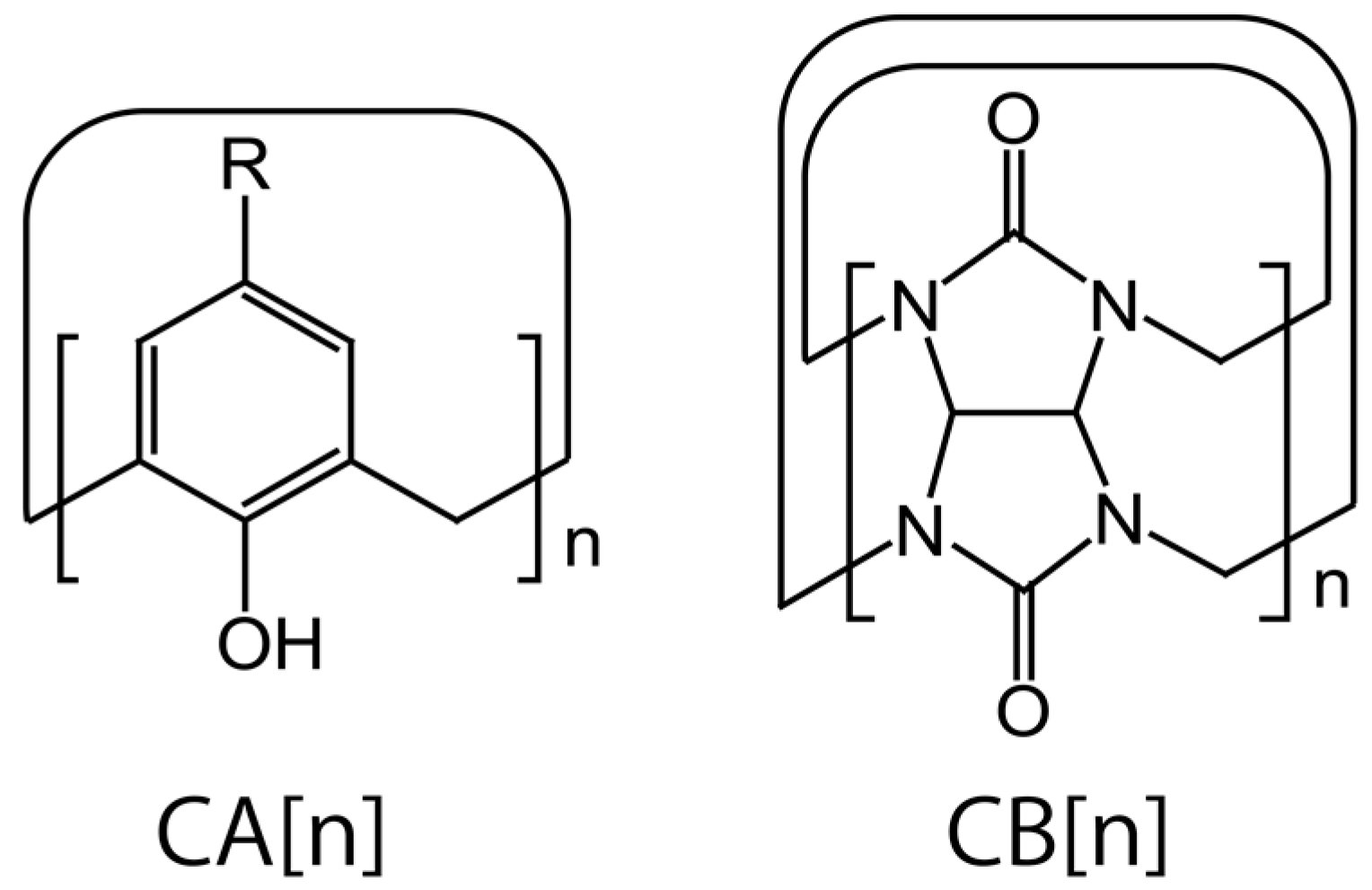
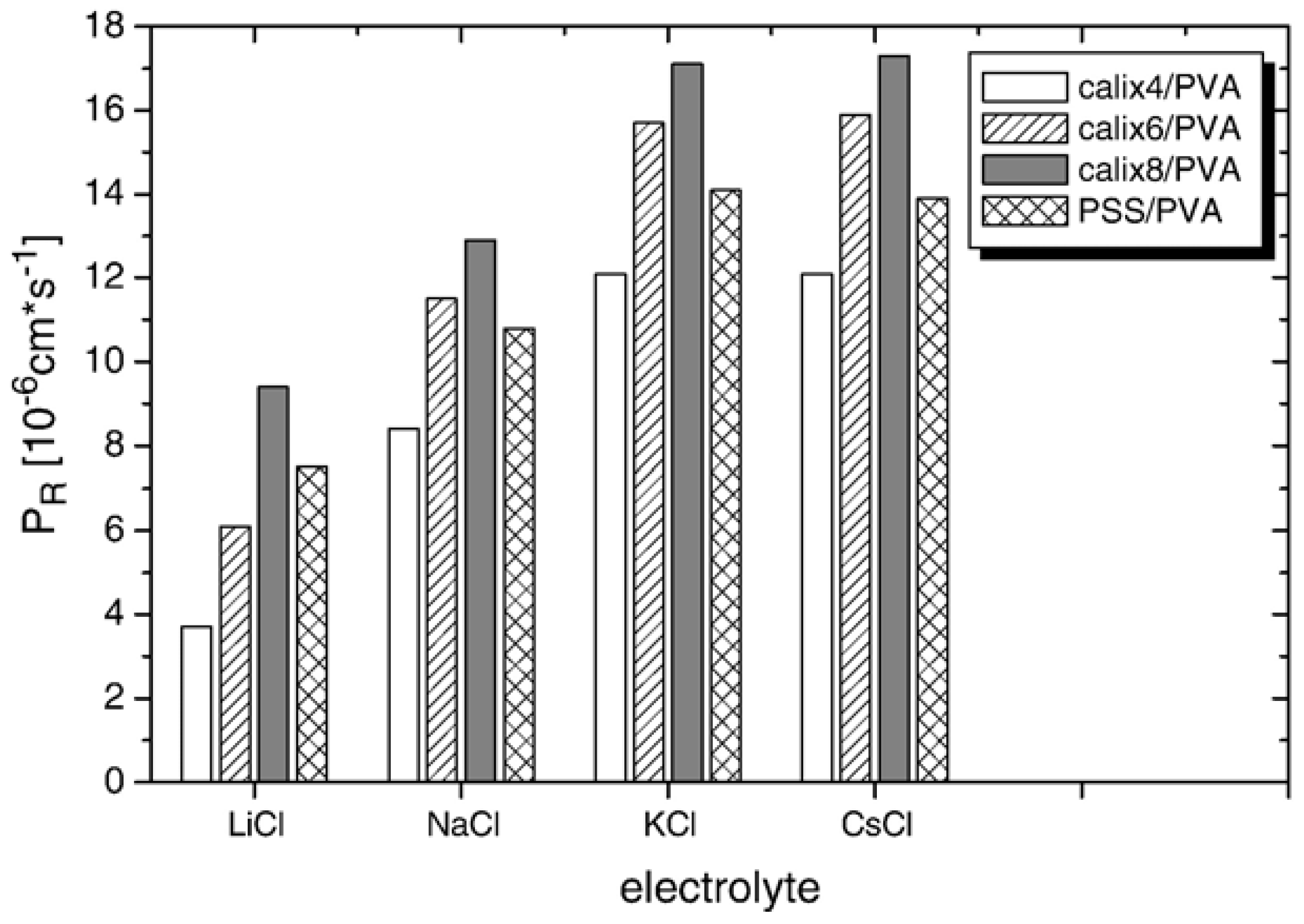



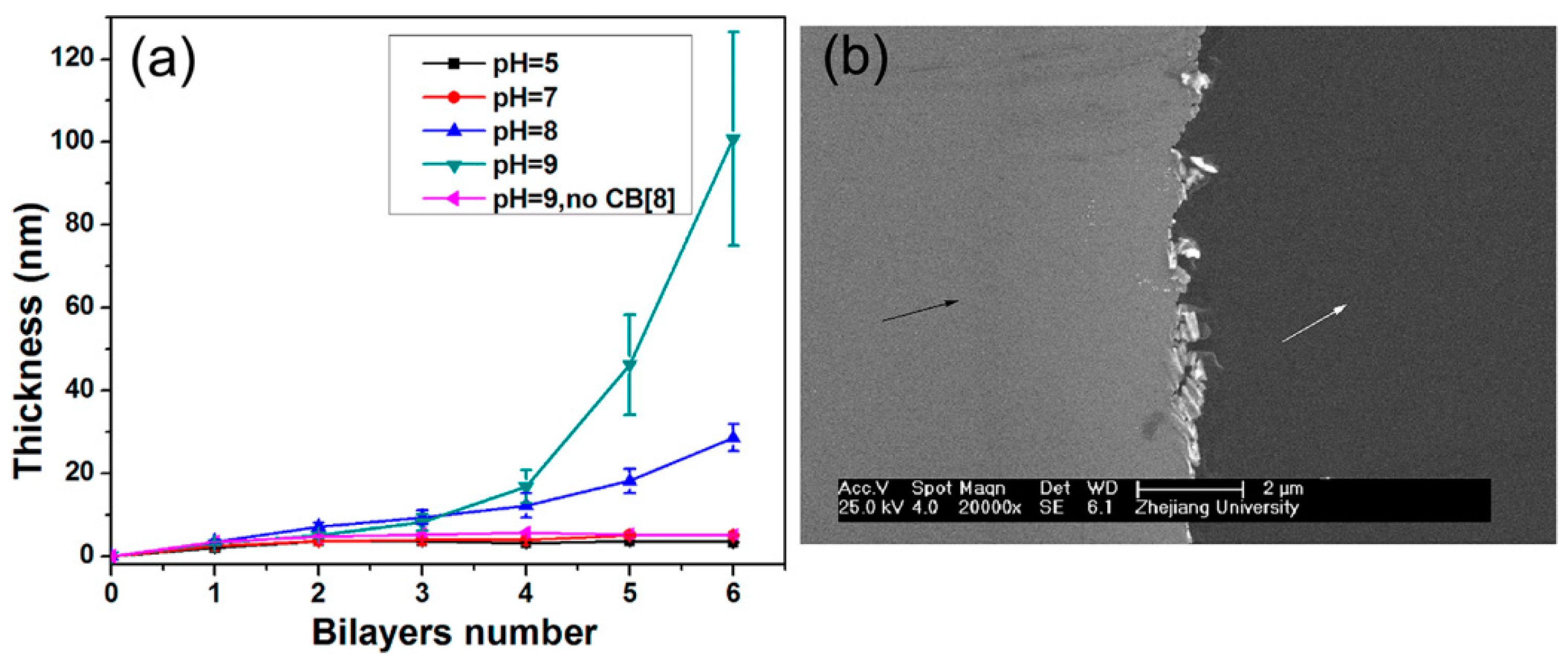
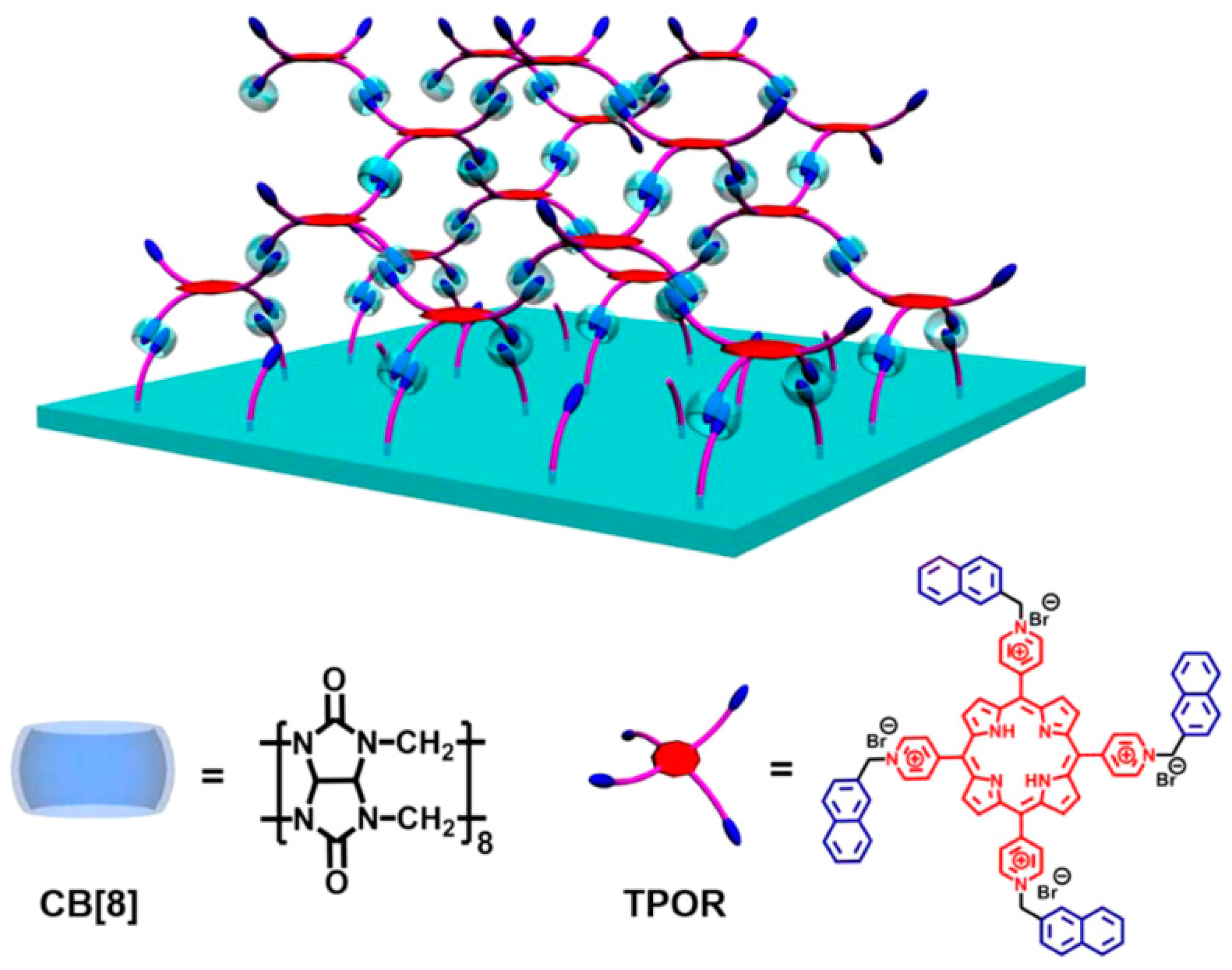
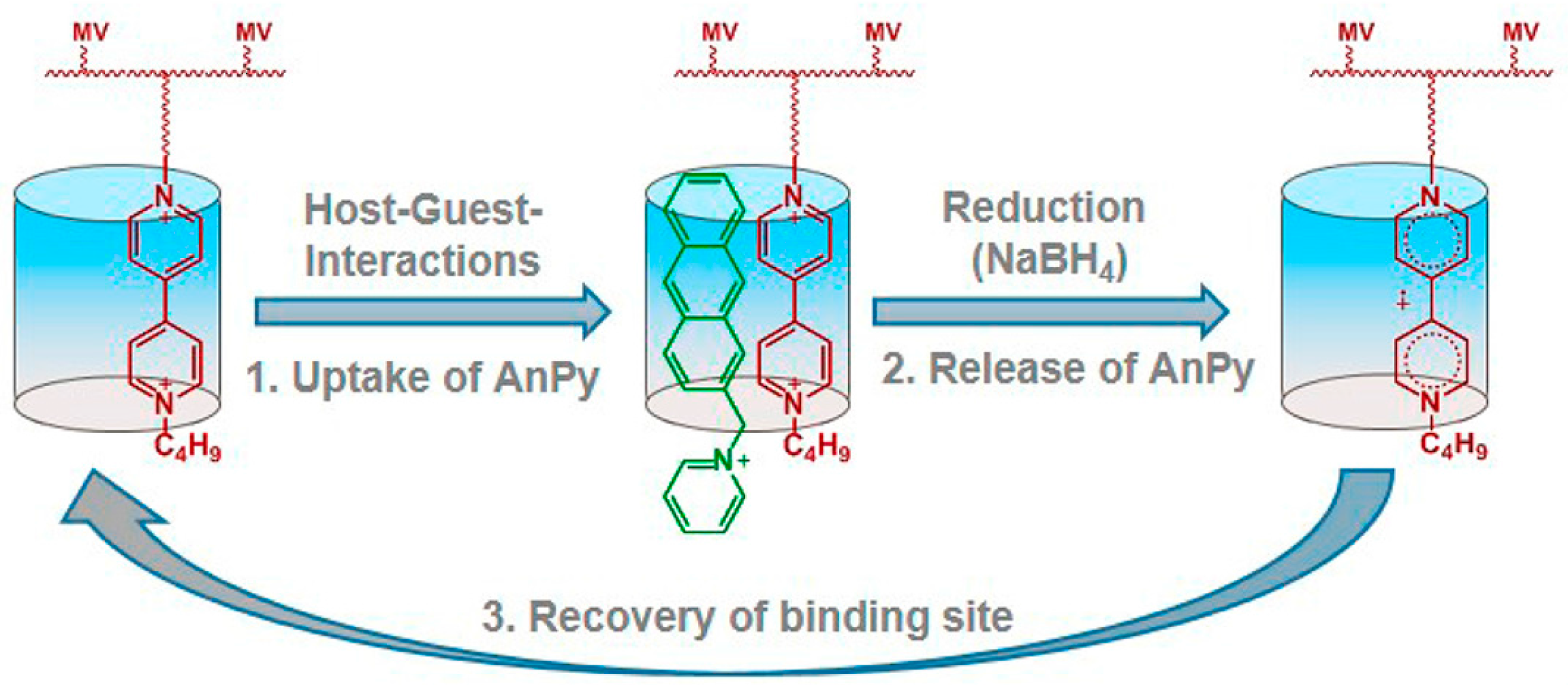
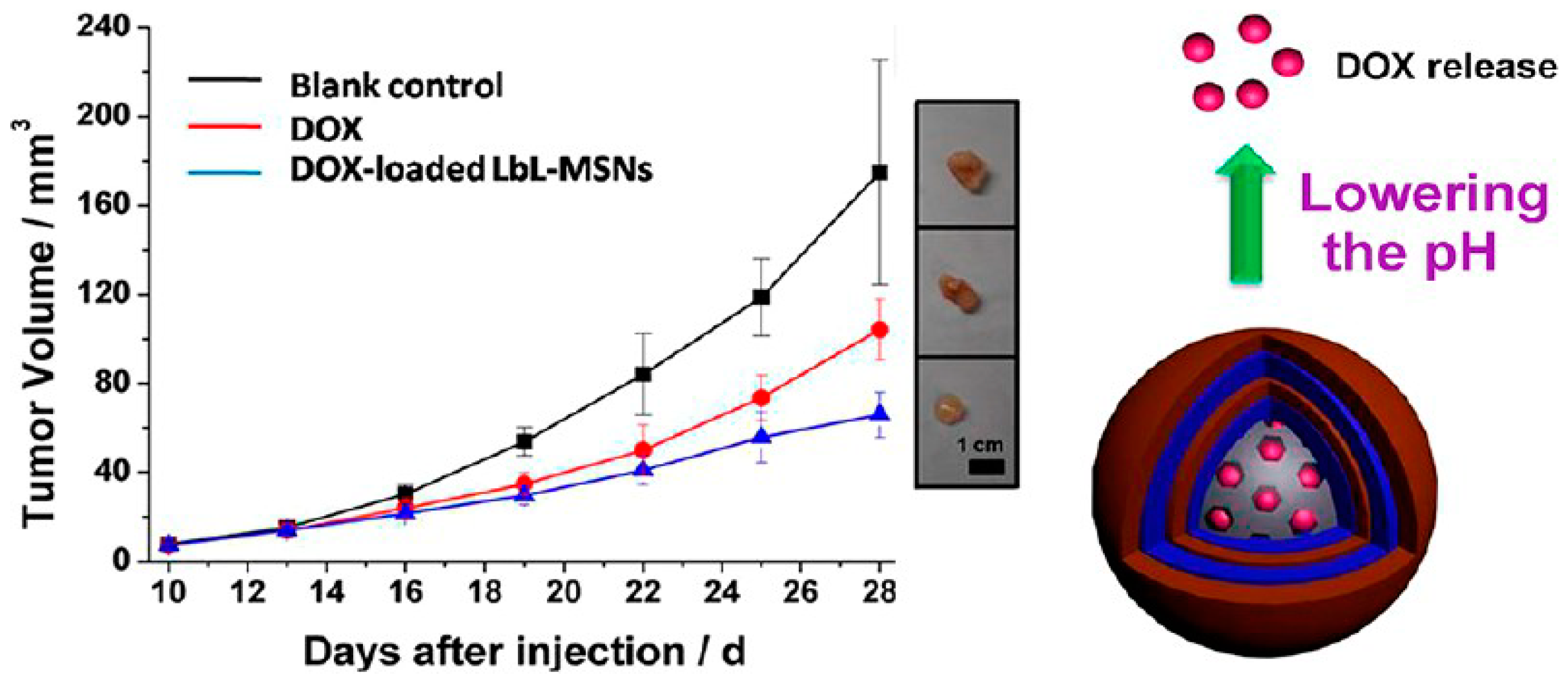
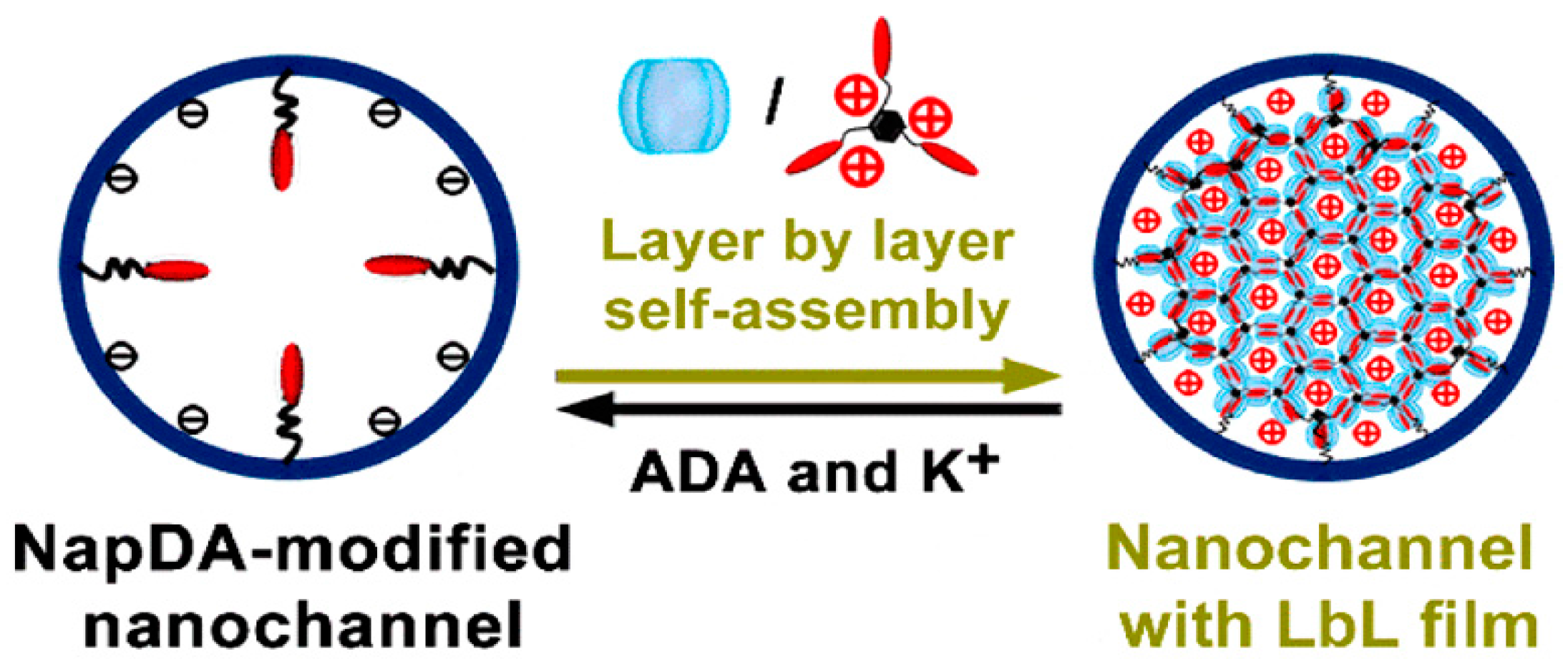
© 2018 by the authors. Licensee MDPI, Basel, Switzerland. This article is an open access article distributed under the terms and conditions of the Creative Commons Attribution (CC BY) license (http://creativecommons.org/licenses/by/4.0/).
Share and Cite
Akiba, U.; Minaki, D.; Anzai, J.-i. Host-Guest Chemistry in Layer-by-Layer Assemblies Containing Calix[n]arenes and Cucurbit[n]urils: A Review. Polymers 2018, 10, 130. https://doi.org/10.3390/polym10020130
Akiba U, Minaki D, Anzai J-i. Host-Guest Chemistry in Layer-by-Layer Assemblies Containing Calix[n]arenes and Cucurbit[n]urils: A Review. Polymers. 2018; 10(2):130. https://doi.org/10.3390/polym10020130
Chicago/Turabian StyleAkiba, Uichi, Daichi Minaki, and Jun-ichi Anzai. 2018. "Host-Guest Chemistry in Layer-by-Layer Assemblies Containing Calix[n]arenes and Cucurbit[n]urils: A Review" Polymers 10, no. 2: 130. https://doi.org/10.3390/polym10020130
APA StyleAkiba, U., Minaki, D., & Anzai, J.-i. (2018). Host-Guest Chemistry in Layer-by-Layer Assemblies Containing Calix[n]arenes and Cucurbit[n]urils: A Review. Polymers, 10(2), 130. https://doi.org/10.3390/polym10020130




